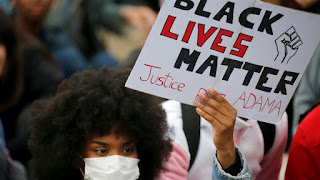By Nickolas Kouravanas
First of all, it is important
to keep in mind that the majority of people have more or less prejudices,
stereotypes, and discrimination against other racial groups. As several people
claim: «No one is born wanting to be racist, sexist, or homophobic».
Misinformation
related to culturally diverse groups is not acquired by our free choice, but
rather imposed through a painful process of cultural conditioning. So, the
perception we usually have about the world is 'we… and the others', that is, we
have a strong sense of 'belonging' and we distinguish our society between our
own group, that is, our 'in - group' as it is called and the ‘out-group’ as it
is called, as well.
Consciously or unconsciously, these biases and prejudices shape our value system and therefore shape both the way we evaluate others around us and the way we treat them. It is certain that most of us find it difficult to express our views on issues of racism that has to do with race, but also racism in general on other identities such as religions, sexuality and so on.
So, one of the strategies we use to cover our racial prejudices is to adopt colorblind attitude. Usually, whites unconsciously subscribe to the belief that people of color are problematic people. In reality, color is not the problem, but society’s perception of color is! In other words, the locus of the problem (racism, sexism, and homophobia) resides not in marginalized groups but in the society, at large. This view of race is manifested in the myth of color blindness: if color is the problem, let's pretend not to see it.
In other words, colorblind attitude is an excuse to exacerbate racial issues and racism in general, by arguing, for example, that "we are all human beings," and that we are all treated as human beings, and as a result nowadays there is not the kind of racism which existed in the past. However, this invisible veil that blinds us and which we put it alone in front of our eyes, does not help us to deal with it and ultimately resolve such issues.
By not recognizing the existence of a problem does not mean that the problem is solved or that it does not exist. We could say that the colorblind attitude has to do with the 'denial' defense mechanism. In this way, the problem is not only degraded, but at the same time it is distorted, and often its avoidance leads both ordinary people and therapists to focus on different aspects of the identity of themselves and of the identity of those marginalized people, for example by focusing on their religion or our religion, or the country from which we come from etc. Whites, for instance, identify themselves as Jewish-Americans, Italian-Americans, Greek – Americans, without realizing that these identities are included in the strongest (dominant) identity that is the ‘white’ identity. Consequently, they do not exactly understand that they belong to the dominant group, and as Whites they have some privileges that people of color do not have, and that they have shaped their worldview according to White's identity. In short, they have never answered to themselves what it means to be white, so they cannot reverse what it means to be black.
The point here, which many therapists themselves cannot see is that many times they take one case, of just one man, and make generalizations by thinking that all Blacks look like the one they have in front of their eyes. Don’t forget that generalization is an essential feature of racism. Another mistake comes when the therapist pathologies the victim by accusing the black person that he/she exaggerates or that he/she causes the wrong behavior of the whites.
Consequently, colorblind
attitude is a defense mechanism for denying that there is a problem of racism
against blacks, thus protecting us from being in a difficult position to judge
ourselves and explaining why we take such a stand against the people of this
marginalized group.
Source:
Sue, B.W. & Sue, D. (2016). Counseling the Culturally Diverse: Theory and Practice.
Sue, B.W. & Sue, D. (2016). Counseling the Culturally Diverse: Theory and Practice.







Δεν υπάρχουν σχόλια:
Δημοσίευση σχολίου